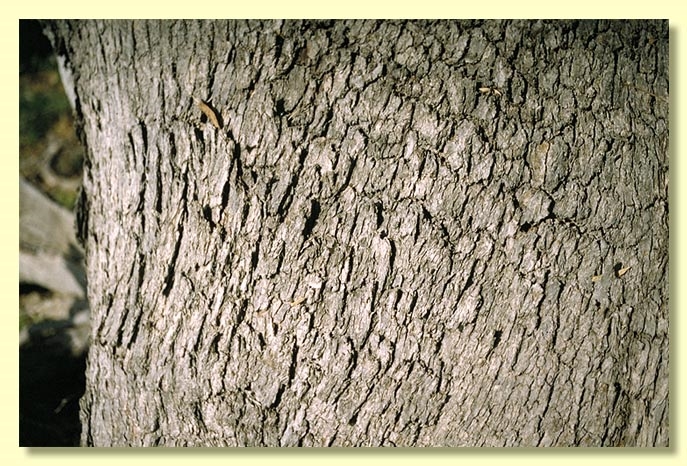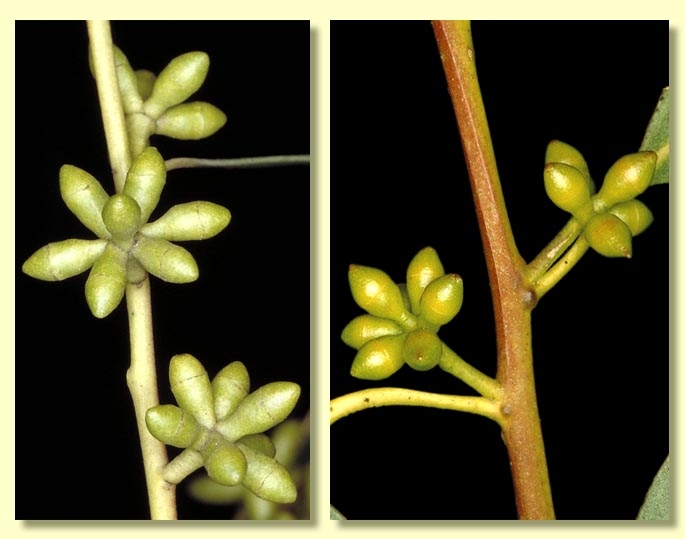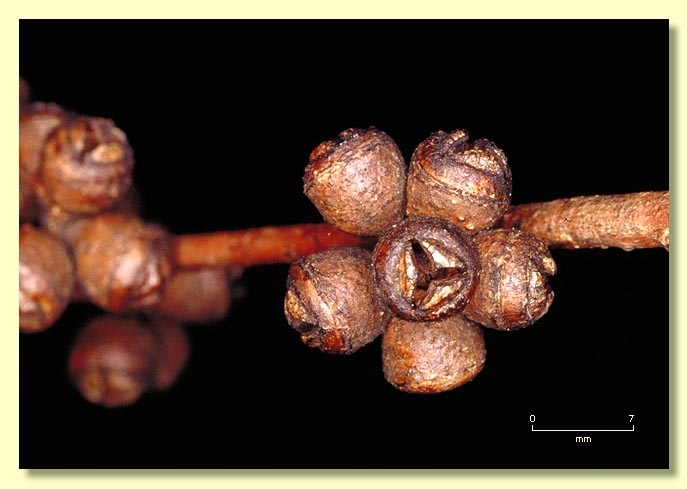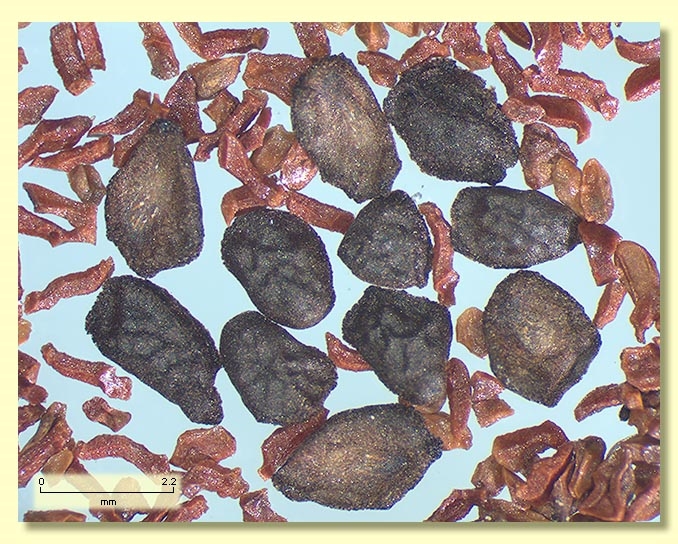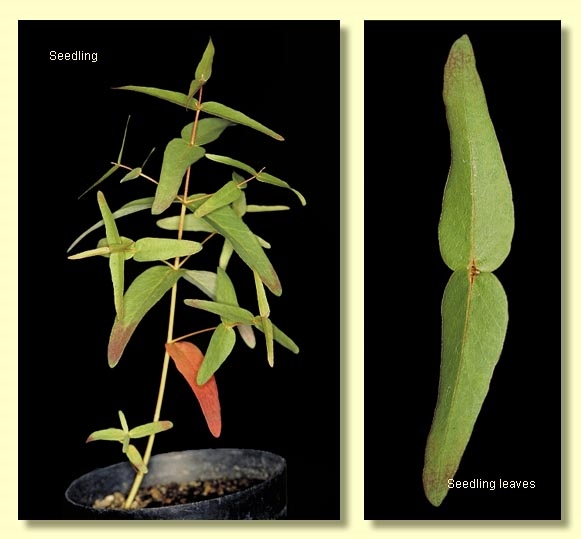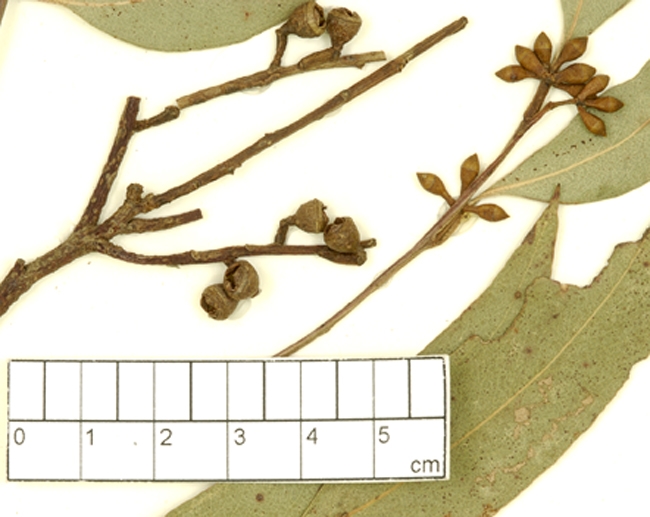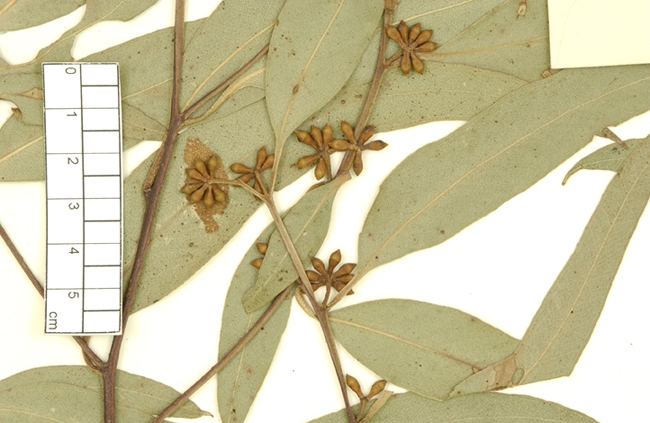Euclid - Online edition
Eucalyptus viminalis subsp. cygnetensis
Eucalyptus | Symphyomyrtus | Maidenaria | Euryotae | Viminales | Lanceolatae
T: Cygnet R., Kangaroo Island, S.A., 10 Dec. 1979, R.C.Hagerstrom & C.D.Boomsma 510; holo: AD; iso: CANB.
[Eucalyptus huberiana auct. non Naudin; W.F.Blakely Key Eucalypts 163 (1934);
E. viminalis var. huberiana (Naudin) N.Burb., Trans. & Proc. Roy. Soc. S. Australia 71: 147 (1947)].
Bark rough at least on trunk, often extending to limbs to about 8 cm diameter, sometimes extending to the twigs, fibrous to box-type becoming tessellated on largest trunks, thick, grey or grey-brown; smooth bark sometimes powdery, white to creamy brown or pale grey.
Juvenile stem rounded or square in cross-section, warty or smooth; juvenile leaves opposite and sessile for many pairs, lanceolate to falcate, 4–8.5 cm long, 0.7–1.8 cm wide, base amplexicaul to rounded, green.
Adult leaves alternate, petiole 0.5–2 cm long; blade lanceolate to falcate, 6–19 cm long, 0.8–3 cm wide, base tapering to petiole, concolorous, glossy, green, side-veins greater than 45° to midrib, moderately to densely reticulate, intramarginal vein parallel to and remote from margin (sometimes double), oil glands mostly island.
Inflorescence axillary unbranched, peduncles 0.3–1 cm long, buds usually 7 per umbel, or sometimes 3 per umbel, occasionally umbels of 3 and 7 buds on the same plant, sessile or on pedicels to 0.3 cm long. Mature buds ovoid to fusiform, 0.5–0.8 cm long, 0.3–0.5 cm wide, yellow-green, scar present, operculum conical to rounded, stamens irregularly flexed, anthers cuboid to oblong, versatile, dorsifixed, dehiscing by longitudinal slits (non-confluent), style long, stigma blunt, locules 3 or 4, the placentae each with 4 vertical ovule rows. Flowers white.
Fruit on pedicels to 0.2 cm long or sessile, cup-shaped to hemispherical, 0.3–0.7 cm long, 0.4–0.9 cm wide, disc raised-convex to concave, valves 3 or 4, exserted or near rim level.
Seeds black, brown or reddish brown, 1.1–2.5 mm long, ovoid or flattened-ovoid, often pointed at one end, lacunose, dorsal surface usually shallowly pitted, hilum ventral.
Cultivated seedlings (measured at ca node 10): cotyledons bilobed; stems rounded to square in cross-section, warty or smooth; leaves sessile, opposite for many nodes, lanceolate to falcate, 3.5–9.5 cm long, 0.7–2.5 cm wide, amplexicaul or base rounded to tapering, margin entire, apex pointed or rounded, discolorous, glossy, green above, paler beneath.
Flowering has been recorded in January, February, March, April and May.
Eucalyptus viminalis is a species of small to very tall tree, widespread in well-watered parts of south-eastern Australia from southern Eyre Peninsula and Kangaroo Island of South Australia through Victoria, Tasmania and eastern New South Wales as far north as the tablelands between Inverell and Deepwater extending east to the escarpment. It is recognised most easily by the many pairs of opposite, sessile, lanceolate, green juvenile leaves. The crown is usually ribbony and the bark is mostly smooth in mountain forms although many populations elsewhere have a black butt or rough bark over most of the trunk. It is related to E. rubida and E. dalrympleana, both of which have rounded, not narrowly lanceolate juvenile leaves. Another seven-budded form, occurring on the Northern Tablelands of New South Wales and its eastern escarpment, has been described recently as E. nobilis (q.v.).
There are four subspecies:
E. viminalis subsp. viminalis
Occurs mostly in wetter or seasonally well-watered areas in New South Wales, Victoria, Tasmania, Bass Strait islands and South Australia, particularly in mountain valleys but also on alluvium along streams on tablelands areas. Subsp. viminalis can be very tall (to 90 m in Tasmania) and is generally smooth-barked and three-budded. In South Australia it occurs only in the central part of the Mt Lofty Ranges.
E. viminalis subsp. cygnetensis
Has rough bark usually to the larger limbs and "umbels of seven buds, infrequently less, to as few as three" (Boomsma, 1980, p. 295). Subsp. cygnetensis occurs from the Grampians in Victoria, south-west to Mt Gambier in South Australia, on Kangaroo Island, in the Port Lincoln area, and in the Mt Lofty Ranges where the rough-barked plants occur with mixtures of umbels in threes and sevens. Plants with 3s and 7s also occur in the Grampians.
E. viminalis subsp. hentyensis
Endemic to Tasmania where it grows on poor white sands on the west coast, north from Strahan. Subsp. hentyensis has little rough bark, coarse, broad juvenile leaves and buds in threes or sevens.
E. viminalis subsp. pryoriana
Subsp. pryoriana is endemic to Victoria and is a small tree of infertile coastal sands from south of Geelong to east of Marlo in Gippsland. It has rough bark over most of the trunk and buds in threes.
In 2011 Rule (see Muelleria 29(1) 5-7) described a new subspecies, Eucalyptus viminalis subsp. siliceana from Wail State Forest on the edge of the Wimmera region of Victoria. This subspecies has buds in umbels of 3s and 7s, buds with a rounded operculum, fruit within the size range of all other subspecies, and field juveniles with leaves narrowly lanceolate, opposite on the stem for many pairs but green to subglaucous with new growth tips glaucous. It occurs on siliceous sands. It is not (yet) included in EUCLID key.
Eucalyptus viminalis belongs in Eucalyptus subgenus Symphyomyrtus section Maidenaria, a large group of species more or less restricted to south-eastern Australia, characterised by bilobed cotyledons, simple axillary inflorescences, buds with two opercula, stamens with versatile anthers and flattened seeds with a ventral hilum. Within this section, E. viminalis belongs in series Viminales subseries Lanceolatae, having buds in threes or sevens, fruit with an ascending disc and exserted valves, and green, sessile, lanceolate juvenile leaves opposite for many pairs.
subsp. cygnetensis: referring to Cygnet River, Kangaroo Island, where the type specimen comes from.


